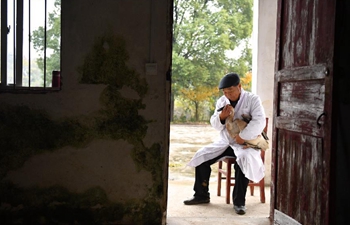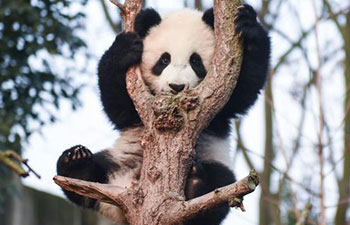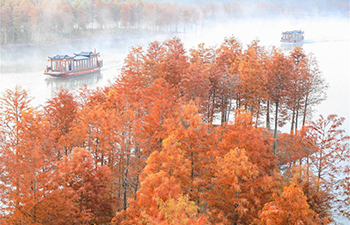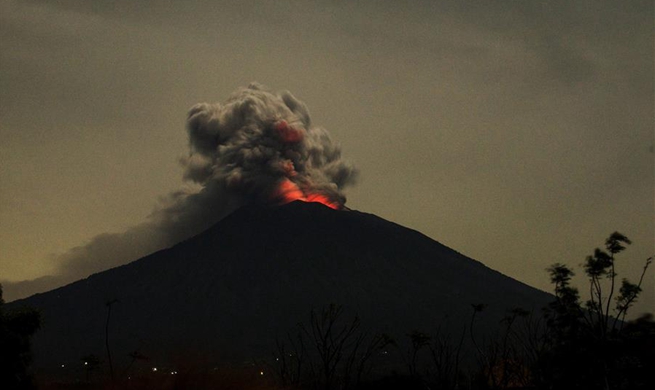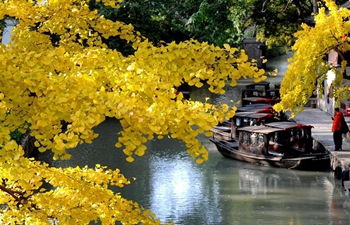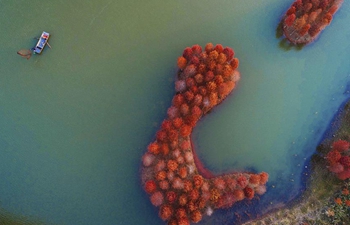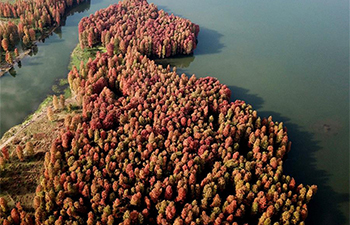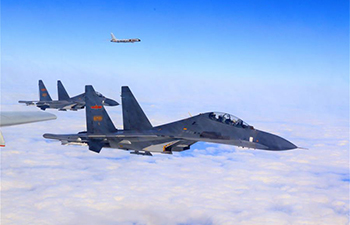by Jin Jing, Gu Zhenqiu
LONDON, Nov. 29 (Xinhua) -- The ongoing Blue Planet II, the BBC's new wildlife series, has become a global hit for its unprecedented exploration into unseen parts of the oceans one month after its first episode was broadcast.
James Honeyborne, executive producer of Blue Planet II, said the development of science and technology in recent years has made it possible for the crew to capture some of the most dramatic moments that even scientists have never seen.
The new series is the sequel to the original 2001 award-winning The Blue Planet, filmed by the Bristol-based BBC Natural History Unit.
"There is a generation of 20 years of new science and new technology. And I knew that would give us the opportunity to tell new stories," Honeyborne told Xinhua in a phone interview.
Honeyborne is highly experienced in documentary production. He has overseen some 35 films, working with multiple co-producers around the world. His recent projects include the Emmy Award-nominated series Wild New Zealand with National Geographic, and the BAFTA-winning Big Blue Live jointly presented by the BBC and PBS.
The first episode of Blue Planet II, premiered on Oct. 29, was rated by the Guardian as the most watched British program of 2017, with the first episode seen by 14.1 million people in the first week of its debut.
The seven-episode series, sold to more than 30 countries, has drawn more than 160 million on-line views in China alone.
To explore and film the unseen world beneath the sea, the team led by Honeyborne developed new technologies. They also also used some off-the-shelf technology.
Unlike conventional divers who can only stay submerged for an hour underwater while generating a lot of noise, the improvements in rebreather diving technology has allowed the crew to stay for much longer underwater without producing bubbles, said Honeyborne.
"The technology has allowed us ...closer proximity to animals in a way that they just totally 'accept' us. That's when we could review their characteristics and their great intelligence," said Honeyborne.
Thanks to this new technology, divers could spend up to four hours with a tusk fish before they capture the moment when the fish cracks open a clam by 'hitting' it against against a coral reef after numerous attempts, he noted
Meanwhile, the camera sensitivity has now become so good that the crew can film images in low light conditions. This was previously impossible only two years ago, said Honeyborne. Submersibles carrying ultra HD and extreme low-light cameras which now are able to record previously unseen events such as hunting packs of the Humboldt squid, at 800 meters deep, he said.
"It's only in 2015, that this technology became available and we were able to film that," said the executive producer.
The new series was more than four years in the making as the crew mounted 125 expeditions, visited 39 countries, and filmed on every continent from the tropics to the poles. They also traversed from familiar shores to the deepest seas, and spent over 6,000 hours diving underwater.
Apart from benefiting from the improvement of the off-the-shelf technology, the crew, teamed up with expert engineers, built their new technologies including the "megadome," a huge split-screen lens which can film and contextualize events above and below the water at the same time.
When filming a walrus sitting on an iceberg, for instance, the audience can see both what's going on, above the huge iceberg as well as what's floating beneath, said Honeyborne.
The team developed a "tow camera" that can travel quickly through the water behind the boat to keep up with fast-moving tuna or dolphins. They also built a "probe camera" that is small enough to go between the branches of coral to give the audience a close-up, wide-angle perspective of what a reef fish would experience itself.
Honeyborne admitted that the ocean is "a dangerous world and it's a world that's rapidly changing."
"There are many potential dangers associated with diving and even submarines so you have to work with the best people in the world. You have to have the best expertise around you in the world to do this sort of expeditions," said Honeyborne.
The BBC executive producer said local help was vital for the team when it comes to currents & tides, changes in visibility as well as sudden changes in the weather.
"The ocean is an unforgiving environment. But if you get it right, she will yield her secrets. And she is also a wonderful and bountiful place to explore," Honeyborne said.
Apart from showing an amazing underwater world, another key message of the new series is that the ocean's health is fragile and that the human race needs a healthy ocean for a healthy planet, he said.
"I am hoping the people will come to care about the ocean through what they see and then together, we could all gain a better understanding of life beneath the waves," said Honeyborne.
During the interview, Honeyborne also expressed his keen interest in possible wildlife filming opportunities in China.
"Clearly there are audiences (in China) that are very interested in the subject...There is a lot of very interesting wild life in China and a lot of stories to be told," he said.




